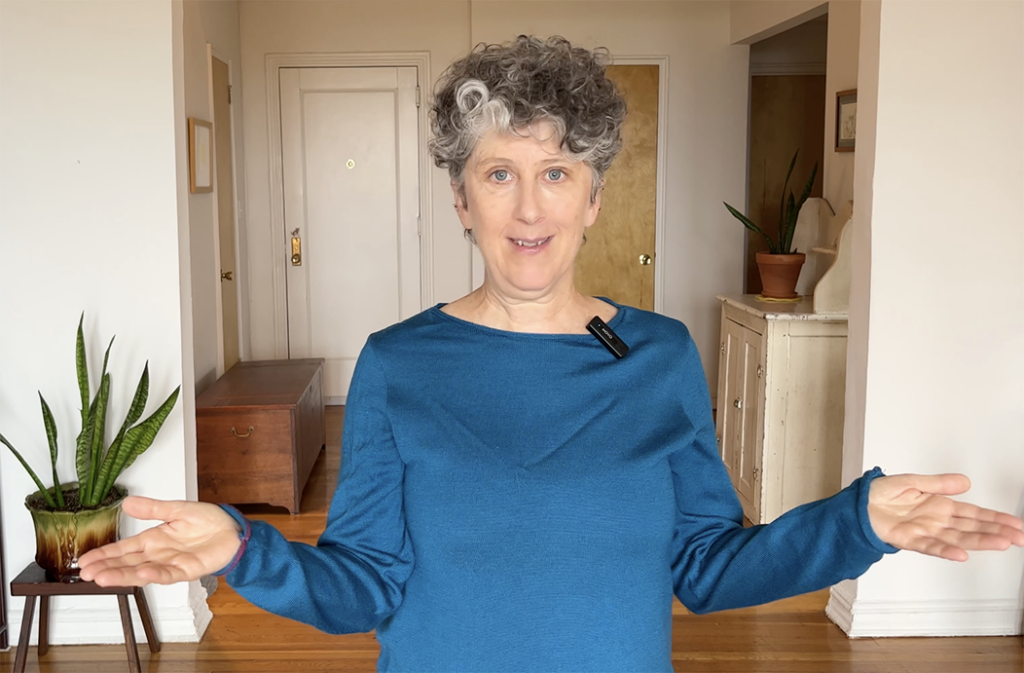
Alexander Technique wisdom for your nervous system
Do you feel conflicted about what to say or do in the presence of suffering? It’s impossible to know what will or won’t exacerbate the pain. This is true when witnessing other people’s struggles, but also in witnessing our own.
Witnessing what’s going on without judgement takes emotional fortitude and specific skill. The Alexander Technique taught me how to do this, step by gentle step. This article gives some context for how important that’s been to me and why. The video guides you in a physical activity to show you what I mean in practical terms.
Being fully present while not trying to change a situation sounds like a great idea, right?
In reality it’s very difficult. Folks get very impatient when you “do nothing,” and to be honest I do too. When I have pain in my heart, or pain in my hip joint, I want it to go away ASAP.
The Alexander Technique faces this very human reality head on by actively cultivating a better relationship between the voluntary and involuntary sides of our nervous system. These are technically called the somatic and autonomic systems.
Understanding the unity of these systems has shown me that doing nothing, with skillful presence, can be a wonderful contribution in a difficult situation.
Your somatic nervous system controls your voluntary muscles. Your autonomic system controls all your organs, involuntary muscles, and other tissues in your body.
One example of how these two systems work together is eating. You open your mouth with voluntary musculature, but once the food is inside you your autonomic system takes over to digest it.
Another example is postural sway. This is a subconscious motion that underlies the voluntary aspects of balance. Today’s video includes a practical activity to complement this post.
Your postural system is constantly adjusting your balance in relationship to the force of gravity. This is going on all the time, whether you are asleep, watching TV, walking, or doing back flips. You need both voluntary and involuntary muscles to manage it all.
You can choose to move through space or to stand still, even to freeze and hold your breath. Eventually, however, your autonomic system will take over, restoring breath motion and postural sway.
Involuntary motions are going on and on and on inside us, all the time. We are and aren’t in control simultaneously.
This relationship between control and involuntary functions allows for incredible complexity. If we had to “think” about the multitude of things that are happening inside our bodies and all around us, we’d go mad!
Thankfully, our autonomic nervous system works perfectly without us having to understand it. Yet, we have a heart-mind, the core of our central nervous systems, that longs to understand how it all works! That consciousness is wondrous too.
How can we best use the tiny bit of control we have to our best advantage?
If you ask your voluntary musculature to quiet down just 3%, you’ll feel internal motions in more detail and nuance.
The less muscular effort you use, the more internal and external sensory information you can process. The more sensation you experience, the better choices you make in response. You will also probably have more vibrant emotional experience, because emotion arises from sensation.
These two parts of you are in constant dialogue, but sometimes the conversation gets too loud or one sided.
When stressed, it can be easier to just go-go-go, and keep on going. We are flooded with the stimuli of our own thoughts and movements, and we can’t feel the ground we are standing on, see other people, or hear their voices.
Or, faced with afternoon exhaustion, we can check out completely, scrolling through our Instagram feed and losing any awareness of what’s going on in and around us. Eventually we come out of it, though, because we really really have to pee!
Take a moment to appreciate that moment when “your body” (your autonomic system) interrupts your conscious activity. Thank you body.
The Alexander Technique amplifies and cultivates that tiny bit of choice, bringing our conscious mind into relationship with our autonomic self.
The conversation between these two parts of you is inescapable and necessary. You might as well accept and utilize it. Step into your power! This power is physical, emotional, and spiritual. For me, the physical way in, being indirect, is easiest.
You can decide to take an action, or you can decide to wait. It’s possible to “do nothing” while staying alert and available, witnessing your autonomic side without trying to boss it around.
You can gather information before taking action.
This week, it has been so difficult and tender to be present with the suffering of war, of the repetitive cycles of genocide echoing endlessly through time. When I get quiet, my own history and vulnerability bubble up inside me.
I feel outrage, terror, dismay. I want an enemy to blame and attack, but I too, at some point, was someone else’s enemy if I go far enough back in time. I remember, with deep gratitude, all the times I have been forgiven for mistakes I’ve made.
Folks have accepted my mistakes and my pain without trying to change me; remembering this, my heart opens to grief and gratitude.
A witnessed body is much more able to soften and open and see new possibilities, once the distress has moved through.
A softened place is a much better place from which to plan action. Reach out and ask a close loved one to witness and hear you if you can. Practicing the Alexander Technique has helped me be a better witness to myself and for others.
I found this NY Times article to be a great example of non-doing despite pressure and resistance.
What I’ve written is my own point of view. It’s not meant as a commentary on what anyone else should or shouldn’t be doing. However, I hope my offering helps you ride the waves of your own experience so that you can make the best contributions to your loved ones and communities during this very difficult time.

Thank you Clare,
This is a wonderful reminder and unique in its approach. I have not read sn article that discusses the somatic and autonomic system with reference to inhibition with such clarity.
Thank you Kay! It was a moment of clarity for me too – worth writing about in order to get it down on paper while it was fresh! I think we have to do a better job, as AT teachers, in bringing inhibition as an activity more alive for people so they can understand how amazing it is to have as a skill when needed.